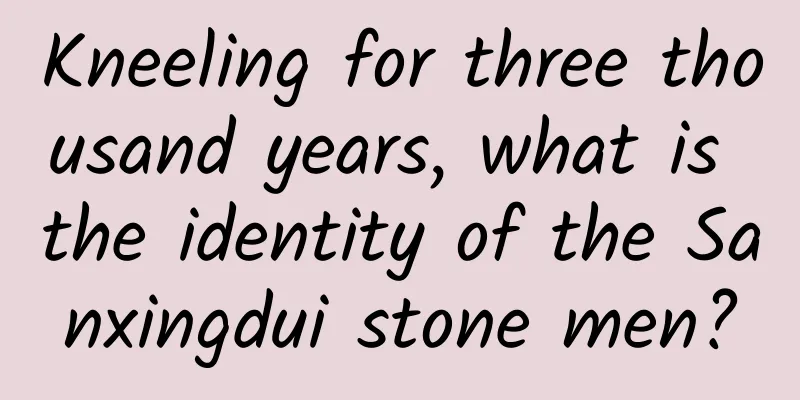Kneeling for three thousand years, what is the identity of the Sanxingdui stone men?

|
On the morning of June 13, a briefing on the progress and main results of the archaeological excavation of the sacrificial area of the Sanxingdui Ruins, an important project of "Archaeology China", was held at the Sanxingdui Museum, attracting a large number of media. It is reported that as of May 2022, of the six sacrificial pits that began excavation in 2020, excavation of Pits 3-6 has been completed. Pits 3 and 4 are currently entering the sorting stage, while Pits 5 and 6 are undergoing laboratory archaeological cleaning; Pits 7 and 8 are in the stage of extracting buried cultural relics. Archaeologists clean up Pit No. 8 (Photo by Wang Qin, Red Star News) The burial accumulations in the pits are as follows: except for Pits 5 and 6 which have only one layer of buried cultural relics under the fill accumulation, the remaining large pits, like Pit 7, are relatively simple, with ivory and mainly thin-sheet gold, bronze and jade artifacts buried directly under the fill accumulation. Pits 3 and 4 both have a layer of ash between the ivory accumulation and the fill accumulation. Among the six newly discovered sacrificial pits, the accumulation in Pit 8 is the most complex: first, numerous bronze objects of different sizes and textures were buried, then a large number of ivory were buried, and then the south and north sides were filled with yellowish-brown sandy soil mixed with red-baked earth blocks, and then the entire pit was covered with ashes, and then filled with yellowish-brown sandy soil mixed with large pieces of red-baked earth and "stone chime" fragments, and finally filled with soil to bury it, which can be said to be layered. During the excavation work over the past year and a half, a total of nearly 13,000 numbered cultural relics have been unearthed from the six pits, including 3,155 relatively complete pieces. Among them, 1,293 cultural relics were unearthed from Pit 3, including 764 bronze artifacts, 104 gold artifacts, 207 jade artifacts, 88 stone artifacts, 11 pottery artifacts, 104 ivory artifacts, and 15 other artifacts; 79 cultural relics were unearthed from Pit 4, including 21 bronze artifacts, 9 jade artifacts, 2 pottery artifacts, and 47 ivory artifacts; 23 items were extracted from Pit 5, including 2 bronze items, 19 gold items, and 2 jade items; In addition to the large wooden box, only two jade artifacts were unearthed from Pit 6, one of which was the unique jade knife; 706 cultural relics were unearthed from Pit 7, including 383 bronze artifacts, 52 gold artifacts, 140 jade artifacts, 1 stone artifact, 62 ivory artifacts, and 68 other artifacts; A total of 1,052 cultural relics have been unearthed from Pit 8, including 68 bronze artifacts, 368 gold artifacts, 205 jade artifacts, 34 stone artifacts, and 377 ivory pieces. Bronze figure kneeling with head turned Among the more than 10,000 cultural relics, the more typical ones include: the kneeling human figure on the bronze-topped urn in Pit 3, the human figure on the bronze-topped altar, the human head on the bronze-topped urn, the small standing human figure with a pointed hat, the bronze head with standing hair, the bronze climbing dragon cover, the bronze coiled dragon cover, the large bronze mask, the bronze round-mouthed square urn, the bronze round urn with an animal head holding a bird, the small bronze mythical beasts, the jade cong with mythical tree pattern, and the engraved jade base; the bronze kneeling human figure with his head turned in Pit 4 and the large gold mask, bird-shaped gold ornaments, and ivory carvings in Pit 5. In addition, the jade knives and wooden boxes from Pit 6, the tortoise-back grid-shaped objects, the copper-topped dragon-shaped ornaments, and the three-hole jade bi-shaped objects from Pit 7, the copper head statue with a gold mask, the copper human statue with a snake body, the copper altar, the copper giant mythical beast, the copper dragon, the copper standing human statue, the copper standing human statue with ivory, the copper pig-nosed dragon-shaped objects, the copper temple-shaped vessel covers, and the stone chimes from Pit 8 are also important discoveries of this archaeological excavation. 1 These new discoveries in Sanxingdui, What new information about the ancient Shu civilization does it bring? Starting from 2020, the archaeological excavation of the six newly discovered sacrificial pits at the Sanxingdui site was included in the major "Archaeology China" project. To this end, the Sichuan Provincial Institute of Cultural Relics and Archaeology has joined forces with 39 domestic scientific research institutions, universities and technology companies to jointly carry out archaeological excavations, cultural relics protection and multidisciplinary research at the Sanxingdui site, and has achieved important phased results. What new information do these important findings bring us about the mysterious ancient Shu civilization from more than 3,000 years ago? First, this round of scientific archaeological excavation further confirmed the age of the Sanxingdui sacrificial pits. By carbon-14 dating nearly 200 samples, the dating data was concentrated between 1131 BC and 1012 BC, with an accuracy of decimal points. In addition, the newly unearthed pottery pointed-bottom cups, pottery high-necked jars, pottery closed-mouth urns, etc. from Sanxingdui are similar in shape to similar objects found at the Lanyuan site of the Jinsha Ruins. From this, it can be seen that, except for Pits 5 and 6, which break the relationship and are slightly later, the burial age of the other pits is consistent, which is the late Shang Dynasty, about 3200 to 3000 years ago, which resolves the controversy over the burial age of the "sacrificial pits" over the past three decades. Extract the Large Bronze Mask This excavation discovered previously unseen artifacts such as large bronze masks, kneeling figures with turned heads, altars, and jade knives, enriching the types of bronze artifacts at the Sanxingdui site. Research suggests that the bronze casting process at Sanxingdui was a combination of mold casting and split casting, using riveting, core bone and other techniques. A particularly exciting new discovery is the discovery of silk in multiple pits through microscopic observation and silk protein analysis, which fills the gap of no silk artifacts in the southwestern region during the Xia and Shang dynasties. Silk residue Taking Pit No. 4 as an example, in the face of the pit full of ashes in the eyes of ordinary people, through scientific plant archaeology, experts analyzed the ashes in the pit and sorted out a list of "lush" plants - the plants represented by the ashes are mainly bamboo, and there are also nanmu, broad-leaved trees, palms, reeds, grasses, cabbage, soybeans, and chenopogon, etc., indicating that the climate of the ancient Shu Kingdom was warm and humid, and the sacrificial area was close to the river and had dense vegetation. In addition, analysis of the residues also showed that the sacrificial animals used by the ancient Shu people included cattle, wild boars, etc. Many new discoveries present a more complete and rich variety of Sanxingdui relics and cultural connotations. Bronze jar from Pit No. 8 (Photo by Red Star News reporter Wang Qin) Several new artifacts unearthed this time show the close cultural connection between the Sanxingdui site and other regions in China. For example, the bronze zun, bronze lei and bronze hu found in pits 3 and 8 are typical bronze artifacts of the Yin and Shang culture in the Central Plains; the jade cong found in pits 3 and 4 are from the Qijia culture in Gansu and Qinghai; the collared jade bi, jade zhang and jade dagger found in pits 3, 7 and 8 are all found in Henan, Shaanxi, Shandong and the vast southern China. The large number of gold artifacts found in each pit is consistent with the ancient tradition of using gold artifacts in the crescent zone. In addition, the discovery of sacred trees, kneeling human figures holding vase-tops, and a large number of dragon-shaped artifacts indicate that the users of the Sanxingdui site had similar self-identity, rituals, religion, and understanding of nature to people in other parts of the country, which undoubtedly shows that the ancient Shu civilization to which the Sanxingdui site belonged was an important member of Chinese civilization. 2 Figures with middle-parted hair unearthed in Sanxingdui, There is something similar at the Jinsha Ruins! Who is “he”? On June 12, Sanxingdui revealed new discoveries next to the archaeological shed. Archaeologists initially confirmed the remains of a house of more than 80 square meters, and successively discovered human figures with middle-parted hairstyles, stone tigers, ivory and other artifacts. Experts believe that there may be small sacrificial pits nearby. In addition, statues of people with various hairstyles, including braided hair and hairpins, have been unearthed in ancient Shu civilization sites including Sanxingdui and Jinsha. Professor Sun Hua of the School of Archaeology and Museology of Peking University once found in his research that hairstyle may be closely related to the ethnic group of the ruling class. So, what is the identity of the statue with a middle-parted hairstyle unearthed from the Sanxingdui site? A stone kneeling figure unearthed from the Sanxingdui site The Jinsha Ruins, which is a direct descendant of the Sanxingdui Ruins, once unearthed 12 stone kneeling figures with middle-parted hairstyles, similar in appearance to the stone kneeling figures discovered at the Sanxingdui Ruins. The stone kneeling figure unearthed from the Jinsha Ruins is naked, barefoot, with his hands tied behind his back, kneeling. His hair is parted in the middle, with the four corners sticking up, like an open book. The two braids behind his head hang down side by side, with the tails covered by his tied hands. His body is slightly leaning forward, and his eyes, mouth and hair on top are all carved with negative lines, and some parts are painted. Holes are drilled in his earlobes, which are a bit like our current ear holes. Many stone kneeling figures were unearthed at the Jinsha Ruins This type of image has been discovered in the Sanxingdui site and the Fangchijie site in Chengdu, but is not found in other parts of China. It should be an artistic statue unique to the ancient Shu Kingdom. 3 He has been kneeling for three thousand years. What is the identity of the stone man? The bronze standing figures unearthed in the Jinsha and Sanxingdui sites symbolize the upper class nobles of the ancient Shu Kingdom who had a special status and were in charge of state power. They all stand on high sockets or square bases, while the stone figures are kneeling with their hands tied behind their backs. One is kneeling and the other is standing, and the two postures form a sharp contrast. Some scholars believe that this may mean that the stone man and the bronze standing man have very different identities, and should represent lower-class people such as slaves, prisoners of war or prisoners. During the sacrificial ceremony, they were buried together with other sacrifices and offered to the gods. However, some scholars have proposed another view based on the "kneeling posture" of the stone kneeling figure. A careful observation shows that although the stone figure is kneeling on both knees, his buttocks are resting on his heels, and his thighs and torso are not upright. According to historical records, ancient people kneeled with their knees on the ground and their hips straight, and sat with their knees on the ground and their buttocks on their heels. "Sitting" is an ancient etiquette and custom. Since the posture of the stone statue is not a kneeling posture with a punishment nature, but a sitting posture with a ritual color, his identity is naturally not a lowly slave or prisoner of war. Stone kneeling figure unearthed from the Jinsha Ruins (front view) Literature also supports this speculation. According to the description in Lüshi Chunqiu: Shunmin, when King Tang of Shang conquered the Xia Dynasty and took control of the country, he encountered a severe drought that lasted for five years. So Tang cut off his hair, tied his fingers with wood, and offered his body as a sacrifice to pray for blessings from the Emperor of Heaven. The people were delighted and heavy rain fell from the sky. "In the past, when Tang conquered Xia and rectified the world, there was a severe drought and no harvest for five years. Tang then prayed in a mulberry forest... Then he cut his hair, rubbed his hands, and sacrificed himself to pray to God. The people were very pleased, and it rained heavily." In this way, the stone statue is similar to King Tang who "praied for rain in the mulberry forest" in the literature. It is an upper-class person who took the initiative to devote himself to the sacrifice. In the ancient Shu society, it may symbolize the wizard who was in charge of religious power at that time. However, these views have not yet been determined in the academic community, and the identity of the stone kneeling figure is still under discussion. Source: Red Star News (ID: cdsbnc), some pictures are from CCTV News |
<<: Space station construction: It’s easier to get things done with people in the sky
>>: If the earth stopped rotating, where could we survive?
Recommend
Advertising data and cases in the home improvement industry
This article shares with you the investment ideas...
Is a piece of porcelain really worth 700 million?
Ancient Chinese Porcelain A perennial favorite at...
Net profit fell by 60%, iFlytek has difficulty telling the ChatGPT story
iFlytek’s unsatisfactory performance in 2022 did ...
How to improve the style of APP interface in details?
[[140092]] The times are always changing in a spi...
How to cold start a new live broadcast account?
This article starts from the perspective of small...
Kuaishou operation and promotion guide, keep it here!
On the occasion of the New Year of 2020, Kuaishou...
Is the customization cost of Puyang automatic printing mini program high? Puyang automatic printing applet customization cost and process
More and more businesses are paying attention to ...
The effects of Guangdiantong and WeChat Moments are not good? Key points for account operation!
There are countless channels for information flow...
Upgrade! Apple iOS 15.2 is officially released: fixes a lot of bugs and adds many new features
[[440213]] Apple today released iOS 15.2 and iPad...
Tiangong already has Hall thrusters, so why is it necessary to transport chemical fuel up there?
At 14:22:22 on July 24, 2022, the Long March 5B Y...
Fake "Lizard"
Nothosaurs are a type of Sauropoda, mainly found ...
Haobo NDA3.0 End-to-end breakthrough in the country
From electric drive to computing power optimizati...
Does iPhone need to clear background activity? This shouldn't be controversial
In 2009, Palm released the first mobile phone equ...
What is the interest rate of the special national debt for fighting the epidemic? How to buy the 2020 special government bonds
On June 18, the special government bonds were iss...
In the competition of patents, which one is better, HTC or OPPO?
One started out as an OEM, and the other started ...









